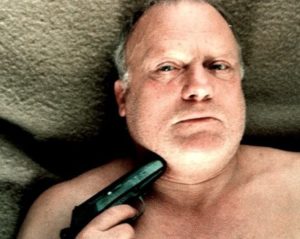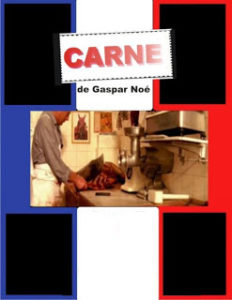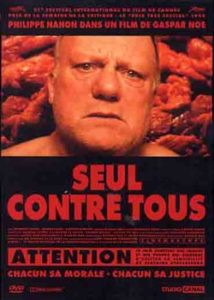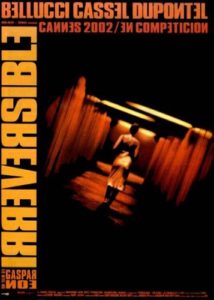 A dour middle-aged butcher and a brilliant young filmmaker: the pairing is an odd one, and yet the Butcher, as he’s known, remains the signature creation of Gaspar Noe, France’s most revered and notorious modern filmmaker. This is a character who clearly means a lot to Mr. Noe, as the Butcher has appeared in no less than three of Noe’s five major films: 1991’s CARNE and 1998’s I STAND ALONE/SEUL CONTRE TOUS, both of which the Butcher headlined, and 2002’s IRREVERSIBLE, in which he made a cameo appearance. (There also exists a fan-made compilation called RANCE that combines the Butcher’s appearances into a single entity, which has the effect of demonstrating that CARNE and I STAND ALONE fit together with remarkable seamlessness despite having been made seven years apart).
A dour middle-aged butcher and a brilliant young filmmaker: the pairing is an odd one, and yet the Butcher, as he’s known, remains the signature creation of Gaspar Noe, France’s most revered and notorious modern filmmaker. This is a character who clearly means a lot to Mr. Noe, as the Butcher has appeared in no less than three of Noe’s five major films: 1991’s CARNE and 1998’s I STAND ALONE/SEUL CONTRE TOUS, both of which the Butcher headlined, and 2002’s IRREVERSIBLE, in which he made a cameo appearance. (There also exists a fan-made compilation called RANCE that combines the Butcher’s appearances into a single entity, which has the effect of demonstrating that CARNE and I STAND ALONE fit together with remarkable seamlessness despite having been made seven years apart).
As played, magnificently, by the veteran French actor Philippe Nahon (whose other screen credits include LE DOULOS, LET SLEEPING CORPSES LIE and HIGH TENSION), the Butcher is a severely angry and possibly psychotic asshole who makes Travis Bickle look like Mary Poppins. Making this guy the protagonist of not one but two films was a mighty daring move on Gaspar Noe’s part. Precisely what hold the Butcher (or possibly the actor who plays him?) has on Mr. Noe I don’t know, but this most peculiar cinematic love affair has been immortalized on three occasions, starting with the 40-minute CARNE.
 CARNE opens with what would become something of a Noe trademark: a textual warning about what we’re about to see, stating “This movie contains images unsuitable for young viewers.” From there we see a horse get butchered and a live birth presented in glorious close-up. Clearly this is a definite not-for-the-squeamish affair!
CARNE opens with what would become something of a Noe trademark: a textual warning about what we’re about to see, stating “This movie contains images unsuitable for young viewers.” From there we see a horse get butchered and a live birth presented in glorious close-up. Clearly this is a definite not-for-the-squeamish affair!
The butcher makes his initial appearance off-screen, with his pregnant wife given the lions’ share of screen time in CARNE’S opening minutes. She dumps her husband shortly after giving birth, leaving him to raise their daughter on his own.
As the Butcher gradually reveals more of his thoughts and attitudes via continuous voice-over narration we come to learn that in addition to being an irreducible grump he’s also a passionate racist and misogynist, and also harbors incestuous desires for his offspring. When he suspects a local punk of manhandling the girl the Butcher reacts in a manner that goes beyond mere fatherly concern.
The Butcher spends a couple days in jail for his actions. Upon getting out he finds himself in desperate straights, with his daughter taken away from him and his overweight female boss, whom he can’t stand, shacking up with him in a remote French province. He’s even more nonplussed upon learning that the cow is pregnant, leading to a nervous breakdown and the loss of his job–and, worst of all to the Butcher, his former place of employment getting taken over by a middle-eastern family.
CARNE, which won a prestigious award at the 1991 Cannes Film Festival, is nothing if not stylistically assured. Visually the film is marked by sharp, jagged compositions bathed in harsh red and yellow-hued illumination, broken up by sudden cuts to black and seemingly unmotivated fast-motion zoom-ins on faces and objects. Most noteworthy of all are the loud thrumming sounds, occasionally followed by off-screen gunshots, which occur in the midst of otherwise mundane scenes, providing a potent aural depiction of the rage-filled cauldron roiling beneath the Butcher’s none-too-placid exterior. All those stylistic quirks were carried over into the Butcher’s second film appearance in I STAND ALONE.
 Unquestionably one of the premiere debut features of the nineties, I STAND ALONE is a positively lacerating cinematic kick in the nuts. Following a still photo montage that lays out the narrative of the earlier film, I STAND ALONE picks up directly where CARNE left off, with an identical visual style and sound design (both of which, I should add, must be experienced on a big screen for maximum impact).
Unquestionably one of the premiere debut features of the nineties, I STAND ALONE is a positively lacerating cinematic kick in the nuts. Following a still photo montage that lays out the narrative of the earlier film, I STAND ALONE picks up directly where CARNE left off, with an identical visual style and sound design (both of which, I should add, must be experienced on a big screen for maximum impact).
Still stuck with his much-hated pregnant spouse, the Butcher spends his days frequenting porno movie theaters. One night, in a fit of rage, he punches his wife in the stomach. Figuring she’ll call the cops, he takes off and hitchhikes to Paris, whose slovenly and selfish residents only confirm his low opinion of humanity. Continually frustrated in his attempts to find work, the Butcher grows increasingly frustrated, indulging in fantasies of revenge against his family, acquaintances, society in general and himself.
Clearly the explosion both films have been inexorably working toward is imminent. This becomes especially evident after an ugly confrontation in a bar, in which the Butcher gives his racist and homophobic leanings a good airing. The underlying tension is increased still further when the Butcher visits his estranged daughter at the prison-like orphanage where she’s interred. He takes her back to his flophouse, and there the long-in-coming explosion finally occurs…
So nasty is the following sequence, involving gore, sex and some profoundly morbid fantasizing, that an onscreen warning shows up beforehand imploring us to leave the theater, complete with a thirty second countdown to give us time to do so.
The concluding scenes suggest that the horrific occurrences of the climactic sequence have a redemptive effect on the Butcher, with his demons finally put to rest. But his final appearance, in a tiny scene at the beginning of Noe’s second feature IRREVERSIBLE, suggests otherwise.
The anti-Noe crowd like to claim the Butcher’s reappearance in IRREVERSIBLE is merely an example of excess self-indulgence on the part of his creator. They may be right, as outside of this four minute scene the Butcher has absolutely nothing to do with the film—which, for the record, is a stunningly bleak and brutal revenge saga headlined by France’s then golden couple Vincent Cassell and Monica Bellucci.
It seems that Noe just couldn’t let this beloved slime ball character go…or maybe Noe was anxious for the Butcher to atone for his actions. For all his love of shock and extremity, Gaspar Noe has a decidedly moralistic bent (it’s a fact that Noe featured himself among the patrons of a gay nightclub in IRREVERSIBLE so he wouldn’t be accused of homophobia). In any event, the fact that IRREVERSIBLE begins with the Butcher’s final appearance is highly significant.
In IRREVERSIBLE, which has a radically different visual style than the previous films—it’s marked by madly swirling camerawork that never stays still—the Butcher appears naked in a nondescript hotel room, regaling an unidentified man about the bad behavior he exhibited in the previous film. It’s a short but a potent scene, serving as both an appropriately caustic tone-setter for the film to come and a loving send-off for the Butcher, who may not fully atone for his sins but does at least come to recognize them.
